#deepriver
Explore tagged Tumblr posts
Text
peter tork had a tumblrina soul. he would do numbers on here
#he'd be using the 💥💥💥 emoji in the tags and starting cute complimenting ask chains and his blog would always have a pretty theme#he'd be like one of the popular funny transfem blogs whose posts always end up on those youtube videos#he'd also post shit like Reblog to give prev a flower. ignore to blow prev up with your mind. etc.#he'd also have his hater moments and those would go viral but fundamentally he'd be funny and nice and have correct opinions#his url would be some shit like flowingcreek or deepriver or greenfields#or probably thetorker. torkster. torkmaster.#anyway. thats my final message. GOODNIGHT
13 notes
·
View notes
Text
also heavily debating leaving twitter the main issue is that's where all the jp artists who like my interests are and also the update accounts for games I play
#milk.txt#🕸️.txt#i saythis like we've used it for more than five seconds since june#outside of sitting on our deep deep deepriv rting art
1 note
·
View note
Text
slepp deeprivation



#marty mcfly fanart#back to the future fanart#sleep deprived af#i regret everything#but also#i regret nothing
12 notes
·
View notes
Text

[ID: a digital drawing of a half-woman with tawny brown skin leaning against a wall. She has purple wavy hair on one side and an undercut with buzzed wave lines on the other. She's wearing a dark purple jacket with black trim and silver buttons, and has a bag stragged to her thigh. The text to her left reads: "Rory Basha: investigative journalist for the Dragon Post." then, in bullet points: "writing the story on Ambrose's kidnapping. hails from Deepriver. excels at dancing badly. has magical moving tattoos. Dawn's love interest." with purple hearts below the last bullet point. end ID]
Rosemond Street's Expansion: Rory Basha!
I have art for you!!! It's been so long!!
A Captured Cauldron, the sequel to A Rival Most Vial, is coming out this fall, and Rosemond Street's gotta make room for some new friends (and lovers, and enemies...)
We'll be in Ambrose, Eli, and Dawn's POV this go-round, which means we get to meet love interest Rory Basha through Dawn's (very infatuated) eyes.
“Sorry about that.” [Rory] staggered to her feet and dusted herself off. “Let me just clear this guy out real quick.” “What?” Dawn stood on tiptoe to look over her shoulder. The convention bar was a shambles. Chairs and barstools lay scattered while peaceful patrons crowded into the side booths, giving the woman and the aforementioned guy—a beefy human with a terrible sneer—space to brawl. “Come on, Franz,” the woman stalked back in, fists raised, grin wide. “If you really call that a punch, I’m gonna tell your editor about it and get you kicked off the adventuring beat.” The man lunged; she ducked, fluid as water.
Next up: Viola, the new baker on Rosemond Street, and Nat, Ambrose's unlikely ally during his adventure below the city!
18 notes
·
View notes
Text
Lost Caverns of Ixalan Draft Booster Challenge
With every set, I like to make a booster pack of custom cards that fit naturally in the set. My goal is to push in novel directions, as much as allowable within the confines of the necessary rarity distribution and within the confines of trying to make cards that don't still feel natural as part of the set. I also aim to try and cover a wide variety of mechanics and themes. I think this is probably my favorite one of these I've done so far, so let's get into it!!!
Art links
Lucía
Grim Captain's Herald
Jade Trident Bearer
Cosmium Compass
Wargnome Smithy // Gnomemaster's Weaponry
Oltec Sun Dial
Caving Gear
Deepriver Frillback
Lost to the Dark
Mycoid Blightwing
Reckless Descent
Sudden Sinkhole
Malamet Combat Rite
Mouth of the Depths
Rare

Lucía, Herald of Aclazotz Legendary Creature- Vampire Demon [mythic] Flying Descend 4 - Whenever Lucía attacks while there are four or more permanent cards in your graveyard, create a 1/1 black Bat creature token with flying that's tapped and attacking. Whenever a Bat, Demon, or Vampire you control deals combat damage to a player, you may pay 2 life. If you do, draw a card. 3/4
An underground set feels like a fun place to put a bat typal effect, but an ixalan set kinda wants its typal focused in the main four creature types. Luckily, Bat pairs very thematically with vampire so I made a the card batch, and threw in Demons for good measure since the card ended up being a vampire demon. Ironically, I think the rare is one of the less boundary pushing cards in this pack, but i like it and within this set it could only be done at rare since all non-Dino typal effects are being kept to rare so I stand by it.
Uncommons

Grim Captain's Herald 4 Creature- Skeleton Spirit Grim Captain's Herald is also a Dinosaur, a Merfolk, a Pirate, and a Vampire. Whenever you cast a Dinosaur, Merfolk, Pirate, and/or Vampire spell, create a Treasure token and put a +1/+1 counter on Grim Captain’s Herald. This ability triggers only once each turn. 2/2
Okay I know I just talked about this set not having a typal thing and all non-dinosaur typal being kept to rare but hear me out. My intention here is to give a reward if you want to build any of the 4 types without devoting larger set structure to it, and I like how since a decent number of the set's creatures are these types it'll always have some hits in whatever deck you put it in or can build a deck specifically filled with just those kinds of creatures. I like it for EDH too, I could see throwing it in decks for any of the 4.

Jade Trident Ranger 3G Creature- Merfolk Warrior When Jade Trident Bearer enters the battlefield, create a tapped Map token. (It’s an artifact with “1, T, Sacrifice this artifact: Target creature you control explores. Activate only as a sorcery.”) Whenever a creature you control explores, it fights up to one target creature you don’t control. 3/3
I wanted to do something fun with maps, and "Fight whenever a creature explores" felt like a fun reward, since it takes advantage of the way explore can help make creatures bigger as well as, with ETB make a map as opposed to ETB explore, the better ability to select what creature of yours you want to fight and when you want it to fight. I went with a tapped map because I don't like green creatures that fight on ETB and an untapped map would be too similar to that.

Cosmium Compass 2 Artifact 2, T: Scry 2. As you discover, you may increase or decrease the discover value by 1. This effect can’t reduce a discover value to less than 1. It points not to the north, but to the unknown.
Here's a discover reward I'm very happy with. The obvious discover reward is the second ability of course, but the scry helps a lot too while also giving the card a use case outside of discover. Originally the use case was "being a creature", but I switched it to artifact with this ability and I'm just much happier with this.
Commons
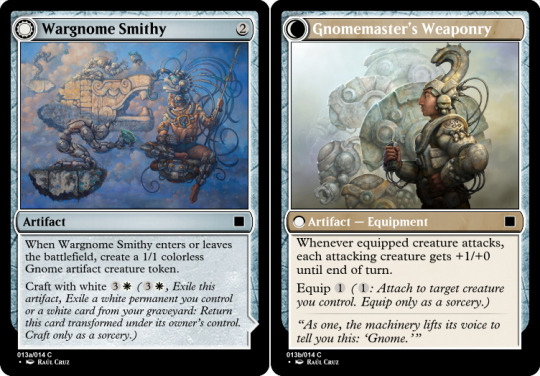
Wargnome Smithy 2 Artifact When Wargnome Smithy enters or leaves the battlefield, create a 1/1 colorless Gnome artifact creature token. Craft with white 3W (3W, Exile this artifact, Exile a white permanent you control or a white card from your graveyard: Return this card transformed under its owner’s control. Craft only as a sorcery.) // Gnomemaster's Weaponry Artifact- Equipment Whenever equipped creature attacks, each attacking creature gets +1/+0 until end of turn. Equip 1 (1: Attach to target creature you control. Equip only as a sorcery.) “As one, the machinery lifts its voice to tell you this: ‘Gnome.’”
First things first, appreciate my flavor text callback. I knew I wanted a craft design in here, and it took me a bit to get something I'm happy with that felt appropriately boundry-pushing but still felt cclean, but i'm very happy with the result. I intend this to be a cycle of colorless artifacts with a colored craft that all have a trigger on ETB and LTB. I like how it has a bit of the flavor of incorporating an aspect of what you craft it with by gaining white as a color. The leave the battlefield effect means it triggers when you use its craft ability, but also that it makes really good craft fodder for other cards. That's the benefit of the cycle being all colorless- you might even take the off color ones to be craft fodder. I think this'll play really interestingly.
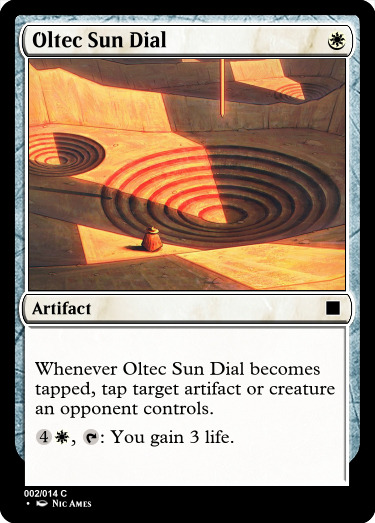
Oltec Sun Dial W Artifact Whenever Oltec Sun Dial becomes tapped, tap target artifact or creature an opponent controls. 4W, T: You gain 3 life.
This card should probably have flavor text but. Eh. This is meant to be a good card for the RW "tap your stuff as a cost" archetype, but I gave it a tap ability to make sure it stood by itself. I wanted the tap ability to be expensive tho to heavily encourage the archetype more.

Caving Gear 2U Artifact- Equipment As a creature you control explores Caving Gear, put this card into your hand. Equipped creature gets +1/+1 and can't be blocked. Equip 2 (2: Attach to target creature you control. Equip only as a sorcery.)
I liked that first line of text on something, but had to figure out what would be a good card to do it on. Something that rewards big creatures felt best, since if this card gets explored that means whatever explored it got a +1/+1 counter on it. Originally it was on a green bite spell, but when I made Jade Trident Bearer that felt to close, so I switched it to blue. Unblockable felt like the best reward in blue for a big creature.

Deepriver Frillback 4U Creature- Dinosaur Vigilance Descend 4 — Deepriver Frillback can’t attack unless there are four or more permanent cards in your graveyard or you discard a card as it attacks. 5/5 The dread it evokes as it chases is almost as deadly as its bite.
"Big blue creature that can only attack conditionally" is well-treaded design space (though it tends to be more upside these days). However, I like the addition I made here of letting you pay a cost if you don't meet the condition yet. And in this particular case I'm happy with how that cost helps you build up to the condition.
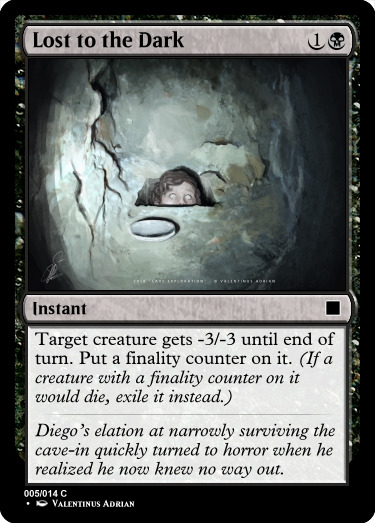
Lost to the Dark 1B Instant Target creature gets -3/-3 until end of turn. Put a finality counter on it. (If a creature with a finality counter on it would die, exile it instead.) Diego’s elation at narrowly surviving the cave-in quickly turned to horror when he realized he now knew no way out.
Finality counters!! love those little guys. Especially since I was able to guess what they were when Mark mentioned a new deciduous counter. I wanted to show off a new way to use them that wasn't in the set (though I can't take credit for this particular innovation, someone in a discord server came up with it). They were only used to limit recursion so far, but here I'm using it in place of the "If that creature would die this turn, exile it instead" with the added benefit that it's not limited to just this turn. a -N/-N effect felt a little better than a red damage spell, because I think the -n/-n is something you're a little more likely to use just to make a creature smaller, instead of killing it. (though still pretty unlikely)

Mycoid Blightwing 3B Creature- Fungus Bat Imp Flying When Mycoid Blightwing is put into your graveyard from anywhere, create a 1/1 black Fungus creature token with “This creature can’t block.” 3/2 Once infected, it feels no hunger or thirst, only the drive to spread spores further.
Here's a card to play into the graveyard themes. Sacrifice it, discard it, mill it, whatever, and you'll get a small reward. I could see it seeing play in modern, getting a reward- especially something on the board- for free always has potential. But a 1/1 that can't block is a small enough thing that I'm not like, worried.
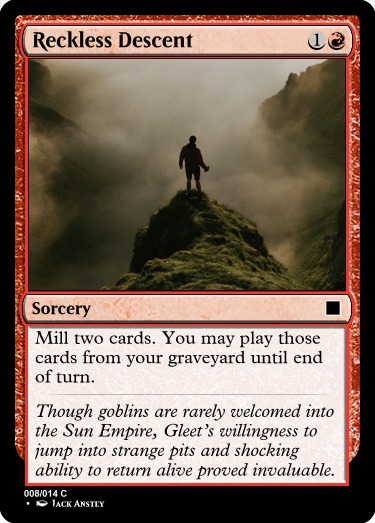
Reckless Descent 1R Sorcery Mill two cards. You may play those cards from your graveyard until end of turn. Though goblins are rarely welcomed into the Sun Empire, Gleet’s willingness to jump into strange pits and shocking ability to return alive proved invaluable.
I've used this mill-based impulse draw in at least two of these booster packs so far, but I see absolutely no reason to stop until wotc finds this for themselves. It seems like an extremely useful tool for graveyard themes, and it's also a great way to show off something novel at common so it feels just perfect for this kind of project. The flavor text is exploring an aspect of the world that's just so odd to me, with the Sun Empire being only humans when there's several sentient species native to the continent. I also like taking goblins usually mocked traits and frames them positively, while staying humorous.

Sudden Sinkhole 3R Sorcery This spell costs 3 less to cast if it targets an artifact. Exile target artifact or nonbasic land. The building collapsed into the previously-unknown depths, never to see the suns again.
Here's a somewhat new take on the pillage design we've seen over and over again. This is a very strong version of the effect, both by itself and in the context of the set which has a strong artifact theme and an unusally high number of nonbasic lands you'll want gone. I went with exile over destroy to hate on craft and caves. This is hopefully even a constructed playable version of this effect which I'm pretty happy with, since the land destruction portion isn't at all strong but having it attached to a more playable card makes it more likely to be around when you really need it.

Malamet Combat Rite 2G Instant Put two +1/+1 counters on target creature you control. You gain life equal to the difference between its power and its base power. Malamet magic enhances not just the warrior’s body, but the warrior’s soul.
This is a version of the "increased power" thing we saw on the two legendary Malamets simplified for common, by giving it a base use case and only caring about a single creature only once. Fun fact- the maximum amount of life you could gain using just the cards in this pack (and basic lands to cast them I suppose) is 7.

Mouth of the Depths Land- Cave T, Mill a card: Add C. Even the most unassuming of entrances can swallow you whole.
This is a mana ability we've seen on creatures before including at common, but never a land, and it felt like a good fit for caves' whole deal and for a very simple synergistic common so I made this once and never changed a thing.
That's all folks!!
12 notes
·
View notes
Text
LÉGENDES DU JAZZ
PEE WEE RUSSELL, DE LA TRADITION À LA MODERNITÉ
“Many people more famous than Pee Wee could walk down a New York street without anybody’s taking the trouble to say hello. New Yorkers are used to seeing the faces of the stars in all fields of endeavor. But there was something about Pee Wee that made everybody, even those who only knew him by reputation, greet him as an old friend wherever he went.”
- Warren W. Vaché
Né le 27 mars 1906 à Maplewood, une banlieue de St. Louis, au Missouri, Charles Ellsworth "Pee Wee" Russell était le seul enfant de Charles Rusell et Ella Ballard. Le père de Russell avait travaillé dans une grande variété de métiers et avait énormément voyagé pour gagner sa vie. Russell portant le même nom que son père, il avait souvent été surnommé Ellsworth pour éviter toute confusion. Très mobile, la famille Russell avait éventuellement quitté Maplewood pour Okmulgee, puis pour Muskogee, en Oklahoma, à peu près à la même époque où Russell avait entrepris ses études élémentaires.
Russell a grandi à Muskogee, en Oklahoma, le lieu de naissance du pianiste Jay McShann. Russell étant fils unique et issu d’un milieu relativement fortuné, ses parents avaient généreusement contribué à ses loisirs et lui avaient payé différents cours de musique. Russell avait d’abord suivi des cours de piano, avant de passer au xylophone, à la batterie et au violon. La carrière de violoniste de Russell avait finalement connu une fin abrupte lorsqu’à l’âge de douze ans, sa mère s’était assise par inadvertance sur son instrument. Mais Russell n’avait pas abandonné sa passion de la musique pour autant. Le grand déclic s’était finalement produit lorsque le père de Russell l’avait emmené assister à un concert du Original Dixieland Jazz Band en 1918. Comme son biographe Robert Hilbert l’écrivait dans son ouvrage intitulé Pee Wee Russell: The Life of a Jazzman publié en 1993,
“One night in 1918, his father took him to an Elks event he had arranged [Russell’s father managed the Elks lodge]... Alcide “Yellow” Nunez [a clarinetist] was holding forth with his band, the Louisiana Five. Nunez, one of the first prominent white jazzmen in New Orleans… was a charter member of the Original Dixieland Jazz Band [ODJB] in Chicago... But the aspect of Nunez’s playing that held young Russell enthralled was the thrill of the unexpected: improvisation.”
Impressionné par les improvisations de Nunez, Russell avait expliqué une quarantaine d’années plus tard: "[He] played the melody, then got hot and played jazz. That was something. How did he know where he was or where he was going?" C’est après ce concert que Russell avait décidé de devenir clarinettiste de jazz.
Déterminé à réaliser son rêve, Russell avait demandé au clarinettiste d’un théâtre local de lui donner des cours. Il s’était aussi acheté une clarinette Albert. Le professeur de Russell était un musicien plutôt pittoresque appelé Charlie Merrill, qui avait l’habitude de prendre de grandes gorgées de whisky durant ses leçons. Un des premiers clarinettistes professionnels de La Nouvelle-Orléans, Merrill se produisait dans la fosse d’orchestre du Broadway Theater. Grand partisan du Original Dixieland Jass Band qui comprenait le clarinettiste Larry Shields, Russell pratiquait de façon tellement consciencieuse qu’il ne lui avait fallu qu’un an pour obtenir un premier contrat avec un groupe local.
Peu après avoir commencé à fréquenter le Central High School en 1919, Russell était déjà dépendant de deux choses: le jazz et la consommation d’alcool. À l’époque, Russell séchait souvent ses cours pour courir les filles, se payer du bon temps et d’autres divertissements du même genre. Après avoir appris que Russell avait accepté un contrat pour jouer sur la rivière Arkansas avec le Deepriver Jazz Band, son père avait décidé que le temps était venu d’inculquer à son fils un peu de discipline. En septembre 1920, il l’avait donc fait inscrire à la Western Military Academy de Alton, dans les Illinois. Russell avait continué à fréquenter l’Académie jusqu’en octobre de l’année suivante, même s’il avait passé le plus clair de son temps à jouer de la clarinette avec différents groupes de danse et de jazz.
De retour à St. Louis avec sa famille en pleine Prohibition, Russell avait découvert que la ville avait gagné une nouvelle énergie souss l’influence du ragtime et du jazz. Parmi les groupes les plus populaires de l’époque, on retrouvait les Mound City Blues Blowers qui étaient dirigés par un chanteur appelé Red McKenzie. Durant cette période, Russell avait aussi joué avec Thomas Sonny Lee, un tromboniste accompli originaire du Texas qui était devenu plus tard une grande vedette avec plusieurs big bands et comme musicien de studio à New York. À la même époque, Russell avait également fait la connaissance du trompettiste Henry Allen et commencé à jouer sur les vapeurs de la Streckfus Line qui faisait la navette sur le Misssissippi.
Mesurant près de six pieds et avec un poids d’environ 125 livres, Russell avait hérité du surnom de ‘’Pee Wee’’.
DÉBUTS DE CARRIÈRE
Après avoir fait partie de différents groupes locaux, Russell avait commencé à jouer professionnellement au début des années 1920 avec le groupe de Herbert Berger à St. Louis. Il avait même joué à Juarez, au Mexique, avec le groupe. C’est d’ailleurs avec le groupe de Berger que Russell avait fait ses débuts sur disque en 1922 sur la pièce "Fuzzy Wuzzy Bird."
En 1922, Russell s’était produit avec les Allen Brothers et sur les navires à vapeur St. Paul et J.S. Il s’était aussi produit avec un des groupes de Charles Creath au Booker T. Washington Theater, qui était un important centre de rassemblement des Afro-Américains à l’époque. En 1923, Russell avait également joué avec différents groupes de danse. Sur la recommandation du tromboniste Thomas Ball ‘’Sonny’’ Lee, Russell avait reçu une offre de Peck Kelley au printemps de 1924 qui l’avait invité à se joindre à son groupe qui se produisait presque exclusivement dans la région de Houston, au Texas. La formation comprenait également le clarinettiste Leon Rappolo et le tromboniste Jack Teagarden qui était devenu un des plus fidèles collaborateurs de Russell par la suite. Lorsque son contrat s’était terminé à l’automne, Russell était retourné à St. Louis et s’était produit avec différents groupes de danse avant d’être contacté par le trompettiste Wingy Man qui l’avait invité à se joindre à son groupe à San Antonio. Après être de nouveau retourné à St. Louis au printemps 1925, Russell avait de nouveau travaillé avec le groupe de Berger.
C’est à cette époque que Russell avait fait la rencontre de Bix Beiderbecke et Frank Trumbauer, avec qui il s’était bientôt produit à l’Arcadia Ballroom. À l’époque, l’Arcadia Ballroom avait engagé Trumbauer comme chef d’orchestre pour la saison s’étendant de septembre 1925 à mai 1926. Pour une brève période, Teagarden avait aussi joué à l’Arcadia, et Russell avait déclaré plus tard qu’il s’agissait du meilleur groupe avec lequel il avait joué au cours de sa carrière. Ouverts à tous les styles musicaux, les membres du groupe s’intéressaient même aux compositeurs classiques modernes. Les performances du groupe au club Blue Lantern de Hudson Lake étaient particulièrement populaires et avaient attiré de futurs grands noms du jazz de Chicago comme Benny Goodman, Bud Freeman et Jimmy McPartland.
Malheureusement, Beiderbecke était alcoolique, ce qui n’avait guère contribué à apaiser la propre passion de Russell pour la dive bouteille. Comme Russell l’avait expliqué plus tard, “We [Beiderbecke and I] hit it right off. We were never apart for a couple of years—day, night, good, bad, sick, well, broke, drunk.”
Après s’être joint en 1926 au groupe de Jean Goldkette, Russell avait quitté St. Louis en août 1927 pour aller jouer à New York avec les célèbres Five Pennies de Red Nichols. Le groupe de Nichols comprenait d’ailleurs des grands noms du jazz comme Glenn Miller et Jack Teagarden au trombone, Bud Freeman au saxophone ténor et Eddie Condon à la guitare. En octobre 1928, Russell avait fait une tournée nationale avec le groupe de Paul Hagan.
Au début des années 1930, Russell s’était produit avec d’autres sommités du jazz comme Bobby Hackett, Red Allen, Edmond Hall, Oran ‘’Hot Lips’’ Page, Jack Bland, Buster Bailey, Coleman Hawkins et Vic Dickenson. Malgré la Grande Dépression, Russell était toujours très populaire, ce qui lui avait permis d’obtenir de nombreux contrats dans les clubs et d’enregistrer à l’occasion avec d’autres grands noms comme Teagarden, Red Allen et Red McKenzie. Anecdote intéressante, lorsque Russell avait fait la connaissance de Hackett en 1933, ce dernier avait abandonné le cornet en faveur de la guitare et du violon. C’est Russell qui avait finalement convaincu Hackett de recommencer à jouer du cornet, ce qui lui avait enfin permis d’être reconnu sur la scène internationale.
Parallèllement à son séjour avec le groupe de Nichols, Russell avait continué de participer à différentes sessions en studio, tant à la clarinette, aux saxophones alto, ténor et soprano, et à la clarinette basse. En 1932, Russell avait même enregistré avec les Rhythmakers à New York. Russell avait aussi joué avec différents chefs d’orchestre dont le trompettiste Louis Prima (1935), avec qui il avait fait des apparitions dans quelques court-métrages pour Paramount et Vitaphone. Le groupe était également très populaire dans les clubs. En 1936, Russell avait fait porter le nombre de membres de son groupe à dix-huit musiciens. Mais lorsque le groupe était arrivé à Chicago, Russell avait développé une pleurésie et avait été incapable de jouer durant deux mois.
Après avait obtenu quelques contrats à Chicago, Russell était retourné à New York en 1937, et avait joué avec un groupe de Dixieland fondé par Red McKenzie et qui comprenait Eddie Condon, Bobby Hackett et le batteur Johnny Blowers. Le groupe se produisait dans un célèbre club-restaurant de Greenwich Village. Propriété de Nick Rongetti, le club était devenu un lieu de rassemblement privilégié des musiciens de jazz durant la période de transition du swing vers le bebop. Malgré son alcoolisme, Russell était devenu un incontournable du club. Rongetti l’avait d’ailleurs congédié et réengagé à de nombreuses reprises. En fait, le groupe était tellement populaire qu’il avait fait l’objet d’un reportage très détaillé dans le magazine Life en août 1938. Devenu une grande vedette, Russell avait inspiré le commentaire suivant à Warren W. Vaché dans son ouvrage Jazz Gentry: Aristocrats of the Music World publié en 1999: “Many people more famous than Pee Wee could walk down a New York street without anybody’s taking the trouble to say hello. New Yorkers are used to seeing the faces of the stars in all fields of endeavor. But there was something about Pee Wee that made everybody, even those who only knew him by reputation, greet him as an old friend wherever he went.” Russell avait même participé à des campagnes de publicité pour le fabricant de clarinettes Conn.
Dans les années 1940, Russell était toujours aussi populaire et avait continué de décrocher de nombreux contrats: enregistrements, fête privées, performances dans les clubs et à la radio... Au milieu des années 1940, Russell s’était joint au cornettiste Jimmy McPartland à Chicago, avant de tomber malade et de retourner au Nick’s, cette fois avec le trompettiste Wild Bill Davison comme chef d’orchestre. À la même époque, Russell avait également enregistré plusieurs pièces pour la compagnie de disques Commodore de Milt Gabler, tant sous son propre nom que comme accompagnateur d’autres musiciens.
Au cours de cette période, Russell avait aussi joué avec le big band de Bobby Hackett et avec le guitariste Eddie Condon, avec qui il avait continué de travailler durant le reste de sa carrière. Ce qui n’avait pas empêché Russell de déclarer: "Those guys [at Nick's and Condon's] made a joke, of me, a clown, and I let myself be treated that way because I was afraid. I didn't know where else to go, where to take refuge". Au milieu de 1939, Russell avait finalement mis fin à sa collaboration avec le big band de Hackett pour retourner jouer au Nick’s avec le groupe de Condon qui était alors dirigé par le saxophoniste Bud Freeman. Le groupe avait finalement été démantelé en juin 1940, même s’il avait participé à une session sous le nom de Bud Freeman’s Chicagoans un mois plus tard.
Dans les années 1940, la santé de Russell avait commencé à devenir précaire, et sa grande consommation d’alcool n’avait guère contribué à améliorer la situation, ce qui avait même provoqué la fin de sa relation avec sa compagne de l’époque, Lola. Comme Russell l’avait expliqué plus tard au critique Whitney Balliett: “For ten years I couldn’t eat anything. All during the forties.... I lived on brandy milkshakes and scrambled-egg sandwiches. And on whiskey. The doctors couldn’t find a thing.... It began to affect my mind....”
Le style de jeu de Russell avait toutefois changé après sa dépression nerveuse. Qualifiant le jeu de Russell, le critique Colin Larkin avait décrit son style comme "a hollow feathery tone framing phrases of an almost Chinese introspection with a tendency to inconclusive garrulity that would have been unheard of in the days when Pee Wee could pack more into a middle eight than any other thirties pick-up player".
En 1942, Russell avait fait partie d’un groupe tout-étoile mis sur pied par Eddie Condon pour les débuts de Fats Waller à Carnegie Hall. Parmi les membres du groupe, on remarquait Bud Freeman et Gene Krupa. Au printemps 1942, Russell avait fait la rencontre de sa future épouse Mary Chaloff. Le couple s’était marié à New York le 11 mars 1943. De trois ans la cadette de Russell, Mary, une jeune femme qui était à la fois très intelligente et très jolie, avait apporté énormément de stabilité à son nouvel époux. Comme l’écrivait le biographe de Russell, Robert Hilbert, “They had a special closeness that had developed out of their bantering relationship... While Pee Wee had developed a dependency on Mary, she was anything but a doormat... She was a strong-willed, independent woman when it was not considered “proper” to be one. She supported Pee Wee’s fragile ego and attempted to give him the personal confidence he often lacked. She made a home for him.” Mais malgré toute sa bonne volonté, Mary ne pouvait protéger Russell de ses anciens démons.
DERNIÈRES ANNÉES
Durant la Seconde Guerre mondiale, Russell avait enregistré des disques pour l’effort de guerre (les célèbres V-Discs). Sa composition ‘’Pee Wee Speaks’’ avait été enregistrée avec Muggsy Spanier et les V-Disc All Stars.
Après avoir été atteint d’une pancréatite qui l’avait forcé à être hospitalisé durant neuf mois et lui avait presque coûté la vie en 1950 (il ne pesait plus que 73 livres à l’époque), Russell avait été victime d’une dépression nerveuse majeure en 1951, ce qui l’avait souvent empêché de se produire sur scène. En fait, Russell était tellement entre la vie et la mort à l’époque qu’on avait même tenu un concert bénéfice en son honneur. Après avoir passé des semaines à l’hôpital et subi plusieurs transfusions sanguines, Russell était retourné à New York et s’était produit aux côtés de Thelonious Monk dans le cadre du Festival de jazz de Newport. Il avait aussi joué avec Duke Ellington.
En 1952, Russell avait recommencé à collaborer avec George Wein et avait formé un groupe qui comprenait le grand cornettiste et innovateur Ruby Braff. Wein, qui était à l’origine de la fondation du Festival de jazz de Newport en 1954, avait d’ailleurs invité Russell à participer au festival en 1963 aux côtés de Thelonious Monk. Dans le cadre de cette performance, Russell avait interprété un long solo sur le classique ‘’Blue Monk.’’ C’est aussi au Festival de Newport que Russell avait joué avec un autre innovateur, le célèbre chef d’orchestre Stan Kenton, pour la première fois. Comme Wein l’avait expliqué plus tard au biographe de Russell, Robert Hilbert, “[He] never met anybody else’s terms. He just kept playing as well as he could play. He was listening to new things all the time and absorbing it all in his ear...” Au cours de sa carrière, Russell avait également joué avec d’autres grands innovateurs comme Gerry Mulligan, Jimmy Giuffre, Kenny Davern et Bobby Gordon.
En décembre 1957, Russell avait aussi fait une apparition dans une des plus grandes performances télévisées de l’histoire du jazz. Intitulée ‘’The Sound of Jazz’’, l’émission était animée par John Crosby et mettait en vedette à la fois les plus grands maîtres de l’époque swing que les innovateurs les plus modernes. Mais même s’il avait commencé à flirter avec le jazz moderne, Russell avait continué de jouer avec des musiciens plus traditionnels comme le trompettiste Buck Clayton et le tromboniste Vic Dickenson. Commentant le travail de Russell avec Clayton en 1960, le critique Stanley Dance écrivait: “Taste is important to both Pee Wee and Buck Clayton, and basically this is therefore a good marriage. Pee Wee, with his sincere approach, tortured lyricism, and ear for harmonies that please and satisfy, seems to fall on he contemporary scene like manna on the desert... He has long been appreciated in many quarters, but it required the current critical climate for his talents to bereverently labeled as Art with a capital.”
En avril 1961, Russell avait accompagné Wein dans le cadre d’une tournée européenne qui comprenait des arrêts à Essen, Berlin, Copenhague et Paris. À son retour aux États-Unis, Russell avait participé à de nombreuses émissions de télévision, dont plusieurs avaient remporté un grand succès. Mais après avoir été contraint de jouer les vieux classiques du Dixieland comme “Muskrat Ramble” et “When the Saints Go Marching In’’ pour la inième fois, Russell avait besoin de passer à autre chose. Il avait donc commencé à choisir ses futures apparitions en public avec soin et avait même décidé de former un quartet plus moderne avec le tromboniste Marshall Brown. Le groupe comprenait également le bassiste Russell George et le batteur Ron Lundberg dans une formule sans piano s’apparentant au quartet de Gerry Mulligan. Le répertoire du groupe comprenait même des compositions de John Coltrane et d’Ornette Coleman. Le groupe avait fait ses débuts en octobre 1962 après une longue période de répétitions, mais les réactions du public et de la critique avaient été mitigées.
Après cet échec relatif, Russell avait recommencé à voyager sous son propre nom. Au début de 1964, Russell se préparait à faire une tournée en Australie, en Nouvelle-Zélande et au Japon avec les Eddie Condon’s All-Stars. La tournée avait été particulièrement gratifiante pour Russell qui avait fait l’objet d’un accueil enthousiaste partout où il se rendait. À son retour en Amérique, Russell s’était produit dans un nombre toujours croissant de festivals de jazz et avait fait la joie des amateurs en interprétant sa célèbre composition “Pee Wee’s Blues.” En septembre de la même année, Russell était de retour en Europe avec Wein et un groupe qui comprenait Braff et Bud Freeman. Par la suite, Russell avait fait un premier séjour en Angleterre, ce qui lui avait permis de se produire avec de nombreux groupes britanniques.
En 1965, Russell, sous l’encouragement de sa femme Mary, avait commencé à faire de la peinture abstraite. Loin d’être dépourvu de talent comme peintre, Russell avait démontré les mêmes dons d’innovation et d’improvisation dans ses tableaux qu’il l’avait toujours fait dans sa musique. Le saxophoniste Bud Freeman était même devenu une sorte d’agent non officiel de Russell et avait fait la promotion de ses tableaux. Comme Freeman l’avait expliqué plus tard au biographe de Russell, Robert Hilbert, “He was so good that people around the world identified more with the idea that he was a famous painter than a clarinet player. So he sold something like 54 paintings for not less than seven hundred dollars a painting.” Loin de délaisser pour autant sa carrière musicale, Russell s’était de nouveau rendu au Mexique dans le cadre d’une tournée organisée par Wein. Il avait également joué à l’Exposition internationale de Montréal en 1967.
Tombée malade en mai 1967 à la suite d’une maladie non identifiée, Mary avait été admise au St. Vincent’s Hospital. On lui avait finalement diagnostiqué un cancer du pancréas. Le décès de Mary le 7 juin suivant avait de nouveau plongé Russell dans la dépression. Le biographe de Russell, Robert Hilbert, écrivait: “Without Mary, Pee Wee’s life— even his music— suddenly meant nothing to him. Just when he at last seemed happy and secure, fate made his worst fear a reality: the self-styled loner finally had to face his demons by himself.”
Même si Russell avait continué de jouer avec une certaine régularité, et plus particulièrement dans la région de Washington, le coeur n’y était plus et le nombre de ses performances était en chute libre. Sur la recommandation d’un ami, Russell avait finalement accepté de se faire admettre à l’hôpital d’Alexandria, en Virginie, en février 1969.
Russell avait livré sa dernière performance avec George Wein lors de la cérémonie d’inauguration du président Richard Nixon le 21 janvier 1969. Pee Wee Russell est mort à l’hôpital d’Alexandria moins de trois semaines plus tard, le 15 février. Son décès a été attribué à une pancréatite et à une cirrhose du foie.
En 1987, Russell a été intronisé au sein du Big Band and Jazz Hall of Fame. Parmi les plus célèbres compositions de Russell, on remarque "Pee Wee's Blues", "Pee Wee Speaks", "Oh! No", "Muskeegie Blues", "Three-Two-One Blues", "Stuyvesant Blues", "Pee Wee's Song", "The Bends Blues", "Midnight Blue", "Englewood", "Cutie Pie", "What's the Pitch", "Missy", "This Is It", "Pee Wee's Tune" et "But Why".
Le style de Russell avait toujours été très original. Les notes jouées par Russell étaient plutôt inorthodoxes comparativement à celles de ses contemporains. On l’avait même parfois accusé à l’occasion de fausser. Au milieu des années 1920, Russell était devenu incontournable comme clarinettiste.
Même si Russell était souvent identifié comme musicien de Dixieland, il avait toujours rejeté cette étiquette. Mais même s’il avait tenté de prendre ses distances face au Dixieland et de s’établir comme un musicien moderne, il n’avait jamais pu s’affranchir totalement de son ancien style qui lui avait permis de bien gagner sa vie. Même s’il avait obtenu plusieurs offres pour jouer avec les meilleurs big bands de son époque, Russell avait toujours préféré se produire avec de petits groupes. À l’exception de son bref séjour avec le big band de Bobby Hackett, Russell avait rarement joué avec de grandes formations.
Reconnu pour son style imprévisible et très original, Russell est considéré de nos jours comme un des clarinettistes les plus innovateurs de l’après-guerre. L’approche unique et non complexée de Russell étant bien avant de son temps, il est même considéré par certains comme un des fondateurs du free jazz. À l’époque de l’enregistrement de l’album Jazz Reunion en 1961, Coleman Hawkins (qui avait enregistré pour la première fois avec Russell en 1929 et le considérait comme un daltonien) avait reconnu les talents d’innovateur de Russell en faisant remarquer que '"For thirty years, I’ve been listening to him play those funny notes. He used to think they were wrong, but they weren't. He’s always been way out, but they didn't have a name for it then."
Les Newport All-Stars ont rendu hommage à Russell dans le cadre d’un blues plutôt lent intitulé "Pee Wee Russell's Unique Sound". Décrivant l’approche unique de Russell de la musique, l’historien du jazz Günther Schuller écrivait en 1991 dans The Swing Era: “...there is something inherently vocal about Russell’s performance. It is as if clarinet and human voice—some remarkably extended voice, to be sure—are welded into one.” Quant au biographe de Russell, Robert Hilbert, il avait commenté: “His was the pure flame. Hot, gritty, profane, real. No matter what physical or mental condition Russell was in, night after night he spun wondrous improvisations. No matter how disjointed his life, how scrambled his mind, how incomprehensible his speech, his music remained logical and authoritative, elegant and graceful, haughty and proud.”
©-2024, tous droits réservés, Les Productions de L’Imaginaire historique
SOURCES:
‘’Charles ‘’Pee Wee’’ Russell (1906-1969).’’ The Syncopated Times, 2024.
‘’Pee Wee Russell.’’ Wikipedia, 2024.
‘’Pee Wee Russell, American musician.’’ Encyclopaedia Britannica, 2024é
‘’Russell, Pee Wee.’’ Encyclopaedia.com, 2019.
3 notes
·
View notes
Text
BEST AMBIENT OF 2023
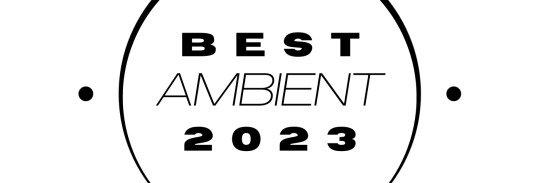
BEST AMBIENT ALBUMS of 2023 curated by @holsgr
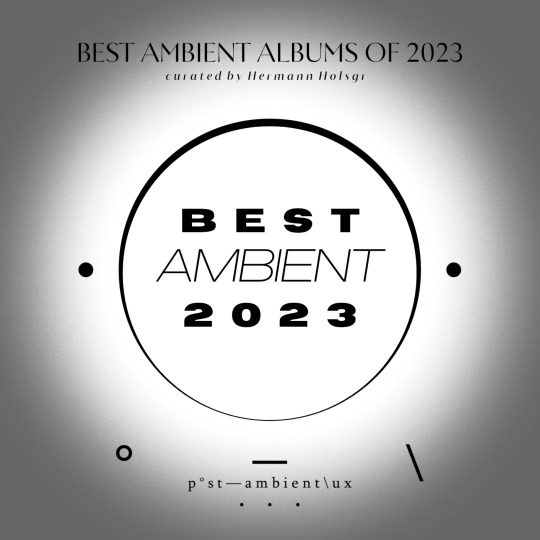
50 : Linus Alberg - Elements
49 : Laurel Halo - Atlas
48 : Alex Smalley - Moments at the Re-engage
47 : Pepo Galán - Family Harmony
46 : Oval - Romantiq
45 : Lunar Corp - Tourism
44 : Henrik Lindstrand - Klangland
43 : Memory Scale - And All Things Begin to Drift
42 : Elskavon - Origins
41 : Bruno Sanfilippo - Ver Sacrum
40 : André 3000 - New Blue Sun
39 : Eluvium - (Whirring Marvels In) Consensus Reality
38 : Martin Kohlstedt - Feld
37 : Loris S. Sarid - A Tiny Reminder
36 : Subheim - Raeon
35 : Claire M Singer - Saor
34 : Faten Kanaan - Afterpoem
33 : Matt Elliott - The End of Days
32 : Gunn Truscinski Nace - Glass Band
31 : Bill Seaman, Tim Diagram & Stephen Spera - The World Was Turning Before
30 : Yosuke Tokunaga - 8 Quadrants
29 : Deepriver - Volume One
28 : Ali Sethi & Nicolas Jaar - Intiha
27 : Maps And Diagrams - A Study of Ends or Purpose
26 : Tim Hecker - No Highs
25 : Tobias Preisig - Closer
24 : Maxime Dangles - Les Délivrés
23 : Graham Lambkin - Aphorisms
22 : Loscil & Lawrence English - Colours Of Air
21 : Hania Rani - Ghosts
20 : Chaz Knapp & Mariel Roberts - Setting Fire to These Dark Times
19 : Sissoko Segal Parisien Peirani - Les Égarés
18 : Grotta Veterano & Music For Sleep - Endless Vacation
17 : Cicada - 棲居在溪源之上 (Seeking the Sources of Streams)
16 : Takashi Kokubo & Andrea Esperti - Music For A Cosmic Garden
15 : Oneohtrix Point Never - Again
14: Raphael Rogiński - Talàn
13 : Lucy Liyou - Dog Dreams (개꿈)
12 : Greg Foat & Gigi Masin - Dolphin
11 : Mette Henriette - Drifting
10 : Marine Eyes & IKSRE - Nurture
9 : Awakened Souls - Unlikely Places
8 : Lemon Quartet - ArtsFest
7 : Zander Raymond - Secrets From A Squirrel
6 : Purelink - Signs
5 : Mary Lattimore - Goodbye, Hotel Arkada
4 : Matthew Halsall - An Ever Changing View
3 : Lia Kohl - The Ceiling Reposes
2 : Rắn Cạp Đuôi Collective - *1
1 : Canaan Balsam - Eternity Lies Within Or Nowhere
BEST AMBIENT EP's OF 2023
10 : KMRU & Abul Mogard - Drawing Water
9 : Hannes Kretzer - Species
8 : Billow Observatory - Calque
7 : Alex Smalley & Lucia Adam - Shapes
6 : Max Ananyev - Scenery
5 : Ben Zucker - After Along the Way
4 : Ideophone - April
3 : James Osland - Sharing Time With You Has Been My Biggest Joy
2 : Jeremixyz - xyz
1 : Lake Haze - Pure Movements
8 notes
·
View notes
Text
Thurs 11th April
Saw James Acaster last night and he was so good and we had a great night

Soooo tired at work today as only got about 5 hours sleep but had a good day. It was nice to wear proper clothes and go into the office. Wanted to work out but having cramps, v sleep deeprived and emotional so just letting myself have an easy week tbh. Maggie gets the vibes

6 notes
·
View notes
Text
If you mean as a meme yeah, first one is idk cream.puff and the guy after is spresso. The concept its self? Yeah this guys lack so much personality we fill in with our own belives and all that....or somthing im sleep deeprived
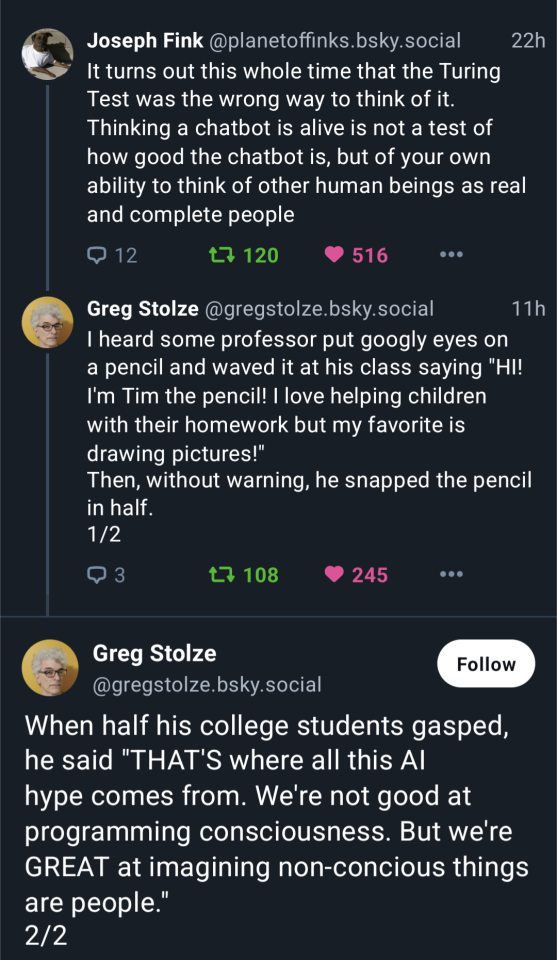
159K notes
·
View notes
Text
this is like my twitter deepriv Cuz nobody know who i am but i have an audience and im on tumblr
0 notes
Text
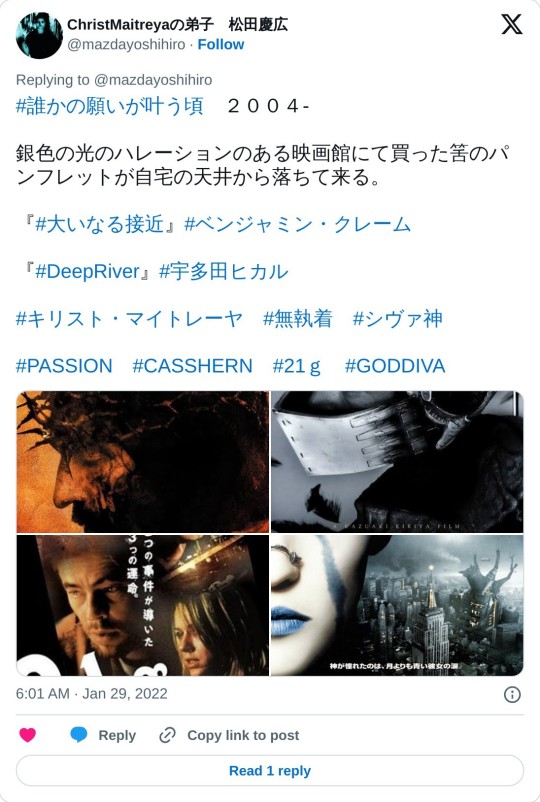
0 notes
Text
youtube
ZOCX『①④才〜FLY IN THE DEEPRIVER』LIVE at 豊洲PIT 2025.03.04
ライブ映像 監督/撮影/編集:二宮ユーキ 撮影:平井侑馬、石綿亮、migi_chang、沖田航宙、タナカマチコ
1 note
·
View note
Text
Hi i'm back
Wish I didn't take so long to get back to this game every time but I got sick...And I am much too prone to just drawing WH instead of playing it. Great for me because it means for as long a time as I want there to be, there will be MORE wh waiting for me!!!!!! ^. ^ (art coming soon btw I really want to finish this cute "impressive" piece and then drop all my less impressive shit alongside it. I enjoy art logs)
Also read my deepriv yap does anyone agree w me
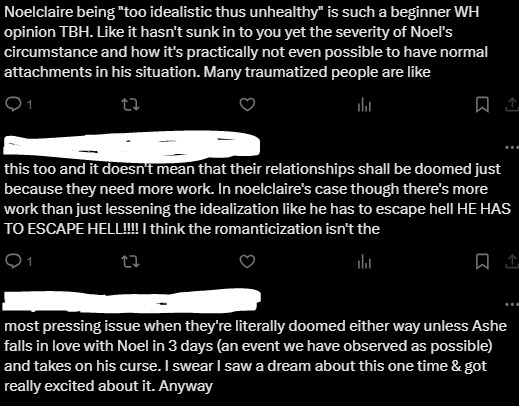
#Im an expert because I had this same nitpicky ass opinion when i was like 15#Sorry about the NoeIclaireashe derail LOL i'm the biggest NoeIclaireashe fan though like actually im sick...#The entire 'i don't like the ship because they're not completely healthy' is such an arbitrary excuse most the time#Like no relationship is gonna be 100% healthy I get preferring healthy fluffy shit although I don't relate but#THIS is sth ppl usually say abt canon/semicanon ships like purely as an excuse for not liking it which is fine to do on its own just excuse#are a little ugly you know. Especially when they make no logical sense but U pretend they do#Didnt mean to get mean sorry just saying I understand the reasons but it's tired. Let urself be OK disliking stuff cuz u have PREFERENCES!!#Okay now back to WiIclaire becoming canon (and more specifically Lime's storybook)
0 notes
Text
Alonzo King Lines Ballet: Deep River - Theater Winterthur 22.12.2023
Alonzo King Lines Ballet: Deep River - Theater Winterthur 22.12.2023 #tanz #gastspiel #alonzoking #choreography #deepriver #lisafischer #theaterwinterthur #dance
Die Company des amerikanischen Choreographen Alonzo King (*1952) gastiert im Theater Winterthur und zeigt die 2022 zum 40jährigen Jubiläum der Kompanie entstandene Arbeit “Deep River” – die knapp 70 Minuten dauernde Choreographie ist eine Verschmelzung von östlichen und westlichen Bewegungstraditionen, ist eine Kombination aus klassischem und zeitgenössischem Tanz…. Continue reading Untitled
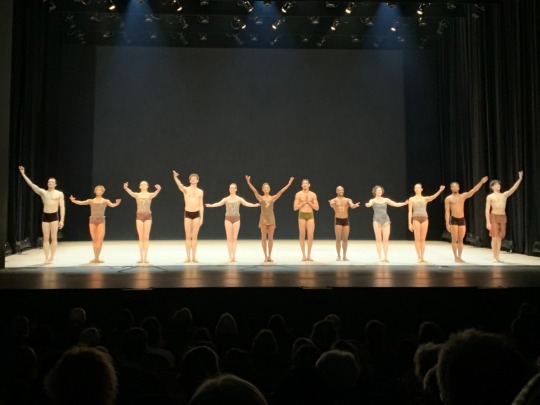
View On WordPress
#Alonzo King#Alonzo King Lines Ballet#Ballett#Deep River#Gastspiel#Kritik#Lisa Fischer#Rezension#Tanz#Theater Winterthur#Vorstellungsbesprechung#Winterthur
0 notes
Note
Happy WBW! I was waxing philosophical to a friend about how weird it is that the world (by my observation) kinda shifted away from the importance of spring and fall to summer and winter as the major seasons. So... what season is the most important-- however you want to decide the meaning-- to your world?
Ooh! I think it’s a little different for each area.
Spring is big in the Scar because the fields around the chasm go nuts with flowers. Absolutely bananas. Everyone in the city loves it, and people come from nearby villages to see it, too.
In Elwig Forest, summer is more important, because that’s when they get the best weather, and in Deepriver, fall is more important because they need to prepare for the annual flooding.
Thanks for the ask!!
8 notes
·
View notes